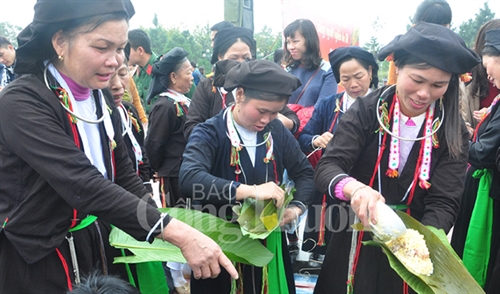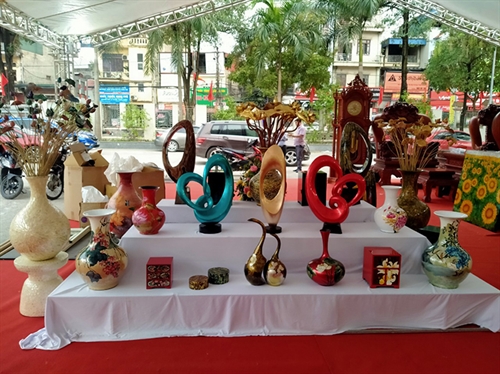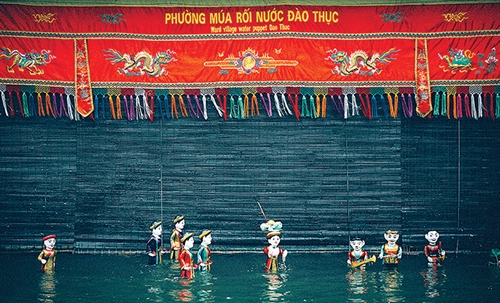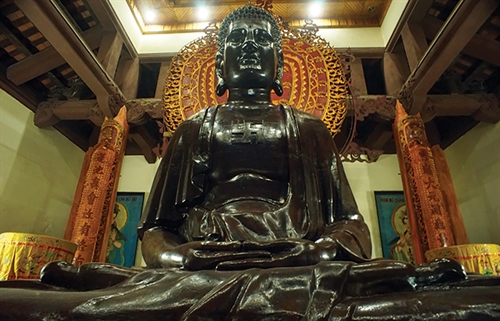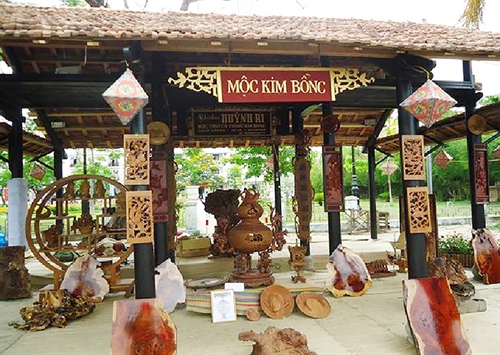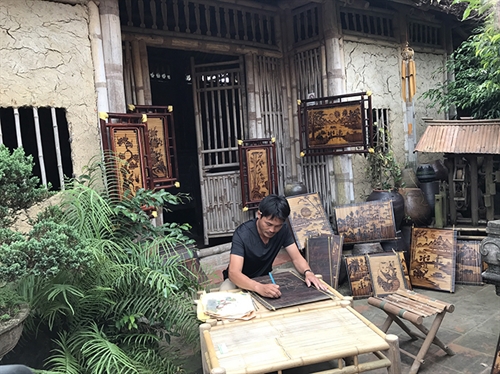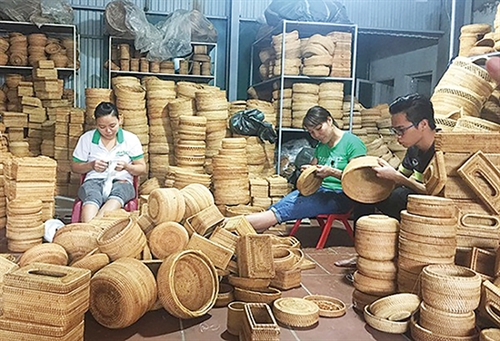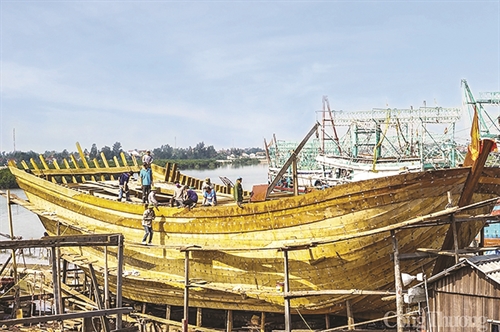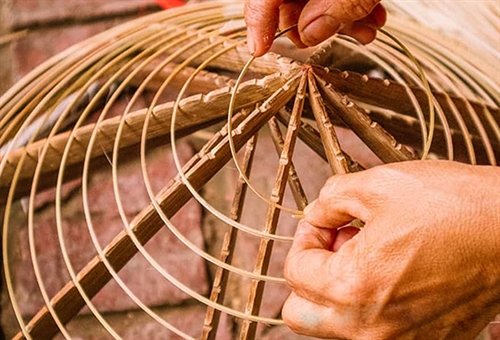Do Thi Nguyet Que
Located on the Red river bank in Moc Nam commune, Duy Tien township, the traditional silk village of Nha Xa has become a famous tourist attraction in Ha Nam province with its well-known plain and jacquard mulberry silk products.
Nha Xa villagers believe that it was Tran Khanh Du, a royal member and renowned general of the Tran dynasty, who founded the guild at some time in the late 13th century or early 14th century. After successfully repelling Yuan-Mongol, General Tran Khanh Du led people from Van Don, Quang Ninh province, to the area which is now Duy Hai commune, Duy Tien township of Ha Nam province to reclaim land. To help people earn their living, the General taught them to plant mulberry, raise silkworms and weave silk. This is the story about the foundation of Nha Xa silk village written in a report about the intangible cultural heritage of Nha Xa silk weaving craft by the Ha Nam Province’s Department of Culture, Sports and Tourism. Nowadays, on the 23rd and 24th of the first lunar month every year during the village festival, Nha Xa villagers hold an incense-offering ceremony to show their gratitude and respect to the founder of the craft.
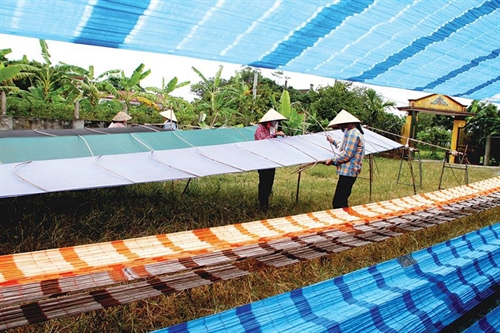 |
| Freshly-dyed silk fabrics hung out to dry__Photo: https://dangcongsan.vn/ |
Through many ups and downs, sericulture practices have faded away but the silk weaving craft still exists until today. Nowadays, Nha Xa weavers no longer produce silk yarns but bought yarns from other craft villages such as Bao Loc town, Lam Dong province. According to President Nguyen Thanh Binh of the Nha Xa Silk Production and Business Association, Nha Xa villagers are now focusing on improving the silk production process so as to raise products’ quality and meet customers’ demand.
The silk production process involves many steps, from spinning, warping, weaving to dyeing.
* Spinning: Although spinning looks simple, it is a time-consuming and painstaking job. In the old days, Nha Xa silk workers used to use a bamboo spinning wheel to disentangle and quill silk yarns on bamboo spindles and shuttles. Today, villagers use electricity-powered silk reeling systems to wind silk yarns around plastic silk bobbins and wooden shuttles.
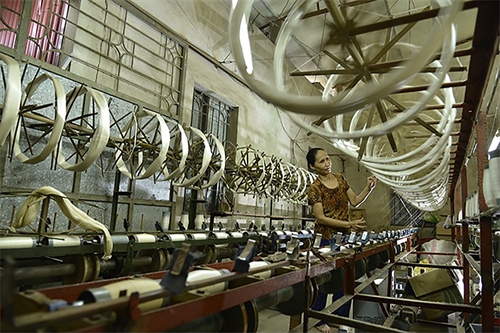 |
Electricity-powered silk reeling systems in Nha Xa silk village__Photo: https://dantocmiennui.vn/ |
| Electricity-powered silk reeling systems in Nha Xa silk village__Photo: https://dantocmiennui.vn/ |
* Warping: Warping is an important step in making silk fabrics which requires patience and punctiliousness. In this stage, warp yarns from plastic bobbins placed on the ground run through a steel creel to wind around a 2.5m diameter rotating horizontal warper operated by an electrical motor. During the warping process, a diligent operator can find the exact place of a broken filament and knot it. This helps prevent a leak or mark on woven silk fabrics. At the end of the stage, the operator removes the warp yarns from the wooden warping machine, passes them through a long comb and rolls them around a wooden beam which is now ready for weaving.
In order to produce a 90cm-wide thin silk fabric, a weaver has to prepare a warp of around 4,200 warp yarns while if wishing to weave a thick silk fabric of the same width, the number of warp yarns will be double, Director Nguyen Van Quyen of the Nha Xa Silk Joint Stock Company told the Vietnam Law & Legal Forum magazine.
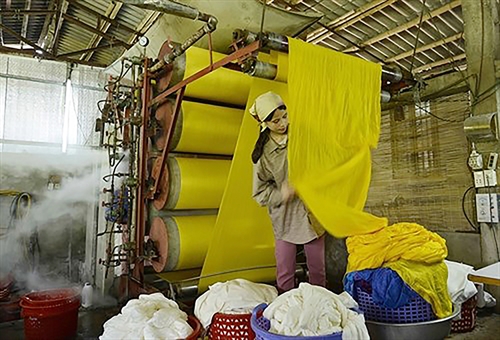 |
Nha Xa silk village’s big workshops use machines to dry and iron silk fabrics__Photo: https://dantocmiennui.vn/ |
| Nha Xa silk village’s big workshops use machines to dry and iron silk fabrics__Photo: https://dantocmiennui.vn/ |
* Weaving: In the past, Nha Xa weavers used bamboo handlooms to weave narrow-width plain silk fabrics. From the 60s of the last century, these handlooms were replaced with electric Jacquard looms that helped save labor, time and costs as an experienced weaver could operate four or five Jacquard looms at the same time. Particularly, Nha Xa villagers have succeeded in renovating cotton-weaving looms of Nam Dinh Textile and Garment Joint Stock Corporation and 8-3 Textile Company Ltd. to produce and as a result, be able to turn out high quality plain and jacquard silk fabrics at lower costs.
* Dyeing: This is the stage when natural silk fabrics are de-gummed and dyed into colorful cloths. Dyeing is considered the heaviest stage in the whole process, hence, it is often performed by men. To start the process, a special scissor is used to cut the knots on silk fabrics or along their edges. Then the fabrics are soaked in hot water to remove sericin, natural macromolecular protein derived from silkworms. Then the fabrics are soaked in a pot of hot water mixed with natural dyes which made from barks, guava or betal leaves, or dioscorea cirrhosa. The pot will be simmered at a low temperature until the fabrics attain the desired shade. Today, in addition to traditional natural dyes, Nha Xa silk producers sometimes mix various chemical dyes to create new eye-catching color. The dyeing time and temperature are the two factors that decide the color of the fabric.-
